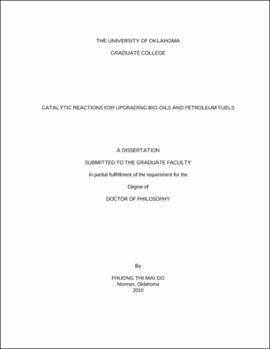| dc.description.abstract | The increasing consumption and phase-out of conventional fuels has derived the tremendous interest of our society in making uses of renewable energy resources such as biomass. In response to this interest, bio-oil produced from biomass feed stocks has been gradually making its contribution as a part of normal fuels. However, since the bio-oil is not stable due to its high oxygen content, upgrading is necessary to improve its performance. In parallel to the need for sustainable fuel sources, a huge desire in creating more environmentally friendly fuels is generated. For instance, lowering emission for conventional diesel and gasoline fuels has been considered one of the actions to reduce the negative impacts of fuel combustion on human health. From point of view of upgrading petroleum fuels, this could partially mean reduction in aromatic content in both diesel and gasoline. In the scope of this dissertation, the author will present two catalytic strategies to improve the performances of bio-oils and conventional diesel and gasoline fuels. Since the high oxygen content of bio-oils has limited its storage ability and lower its heating content, in some cases, removing oxygen or deoxygenating bio-oil molecules has been proposed as a recommended catalytic reaction. In the first part of the dissertation, the author will focus on the deoxygenation reaction of methyl esters and triglycerides, which can be derived from biomass feed stocks and contain the ester functional group (-COO-) relevant to bio-oil molecules. Hydrocarbons are the desired products from the deoxygenation reactions. The first step in optimizing the yield and selectivity of the hydrocarbons is to establish the reaction mechanisms with all possible reaction pathways leading to formation of hydrocarbons. In addition, the effects of various parameters on the deoxygenation reactions have been examined. The important parameters include pressure, temperature, hydrogen partial pressure, and reactor configuration. Certainly, one cannot exclude the important role of catalysts. The catalysts implemented in these reactions were supported noble-metal-based catalysts such as Pt and Pd. The variation of these parameters will be used in the reactions of several representative molecules such as methyl hexanoate, methyl octanoate, methyl dodecanone, and triacetin. A number of interesting findings on reaction mechanism, catalyst deactivation, and the role of active sites have been drawn from these studies. The second part of this work has touched on the upgrading reactions of aromatics in petroleum fuel. Hydrogenation of the aromatic rings followed by selective ring opening of the corresponding naphthenic compounds has been proposed as one of the strategies to improve the cetane number and other fuel properties. In this work, the ring opening reactions of various naphthenic compounds on different modified Iridium catalysts have been studied. The supported Iridium catalysts are not only active for ring opening reaction but also selective for certain positions of C-C cleavage when supports and additive modifications are applied. Although the two parts of this dissertation deal with different feed molecules, they all bring the common understandings on how to modify the reaction variables to optimize the selective production of hydrocarbon fuels. | |
